#possumhaw viburnum
Photo
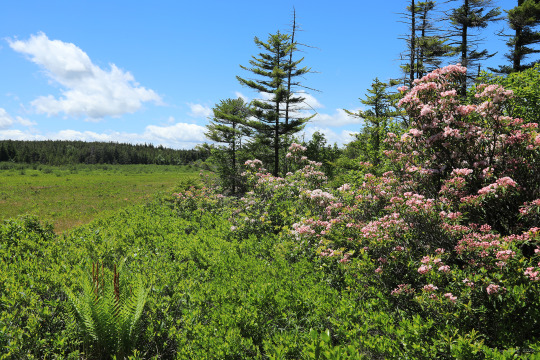
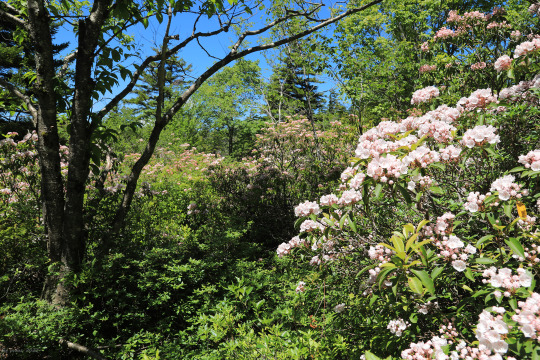
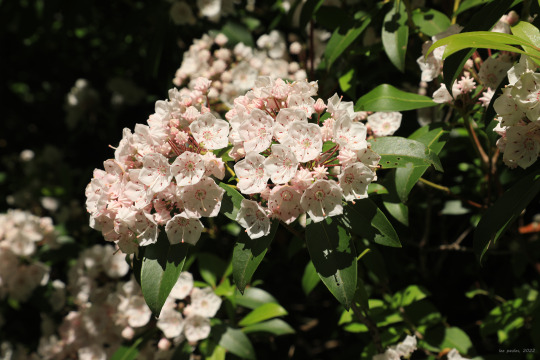
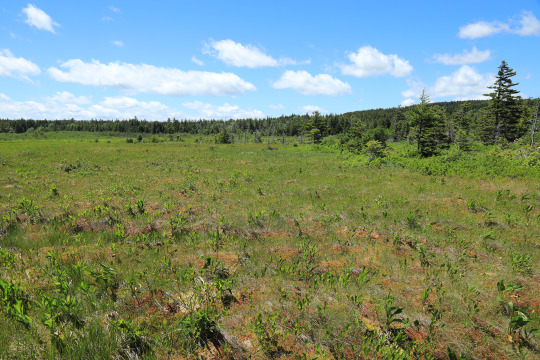
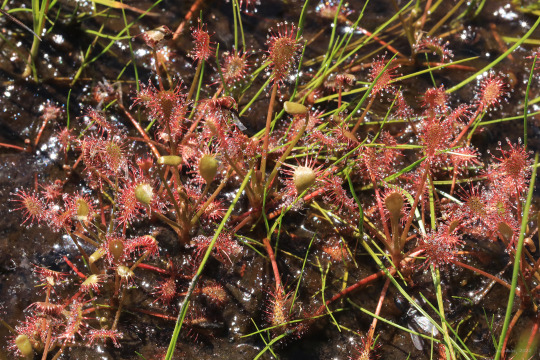
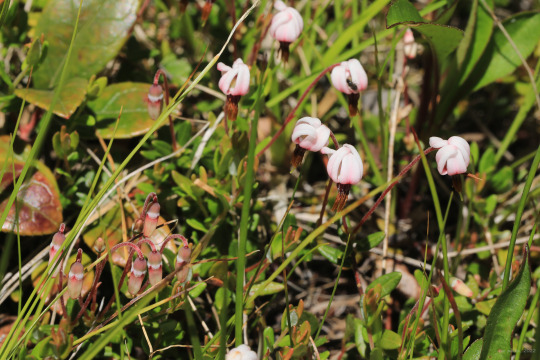


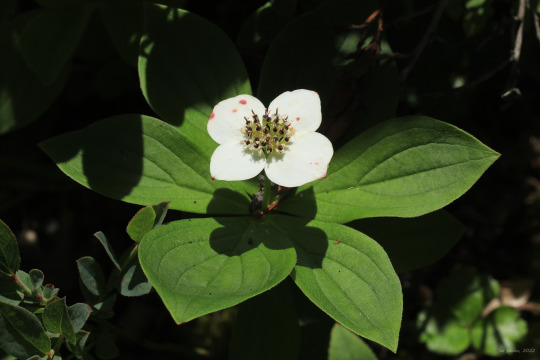
Dolly Sods and the adjacent Flat Rock and Roaring Plains sprawl across a rugged plateau at the edge of the Allegheny Front, which drains much of the moisture from passing clouds. The water drains poorly on the plateau, resulting in sphagnum bogs that host a variety of plants and animals uniquely adapted to the cool, acidic environment.
From top: Mountain laurel (Kalmia latifolia), which in combination with blueberry, huckleberry and minniebush forms impenetrable thickets along the edges of the bogs; spoonleaf sundew (Drosera intermedia), also known as spatulate-leaved sundew, one of two species of carnivorous sundew to grow here; small cranberry (Vaccinium oxycoccos), also known as bog cranberry, whose tiny flowers have strongly recurved petals; possumhaw viburnum (Viburnum nudum), also known as wild raisin due to its vibrantly-hued fruits in the fall; canaan fir (Abies balsamea var. phanerolepis), a recognized subspecies of balsam fir known from only a few locations in West Virginia and Virginia; and bunchberry (Cornus canadensis), which grows prolifically in the dappled sunlight along trail edges.
#appalachia#vandalia#west virginia#allegheny mountains#allegheny front#dolly sods#dolly sods wilderness#flora#wildflowers#wetlands#sphagnum moss#peat bog#sphagnum bog#kalmia latifolia#mountain laurel#drosera intermedia#spoonleaf sundew#spatulate-leaved sundew#vaccinium oxycoccus#small cranberry#bog cranberry#viburnum nudum#possumhaw#wild raisin#smooth witherod#abies balsamea var. phanerolepis#canaan fir#cornus canadensis#bunchberry#monongahela national forest
136 notes
·
View notes
Text



Viburnum nudum - possumhaw viburnum
17 notes
·
View notes
Photo

A possumhaw viburnum/“wild raisin” (Viburnum nudum var. cassinoides) (front), another moth-pollinated plant that should eventually bear edible berries. The American persimmon sapling (back) is growing very nicely, and has a single little greater angle-wing katydid (Microcentrum rhombifolium) that has been living on it since the first week of June and has also been growing a lot https://www.instagram.com/p/B0E_4JQBDaK/?igshid=rymvu5jazffa
3 notes
·
View notes
Photo

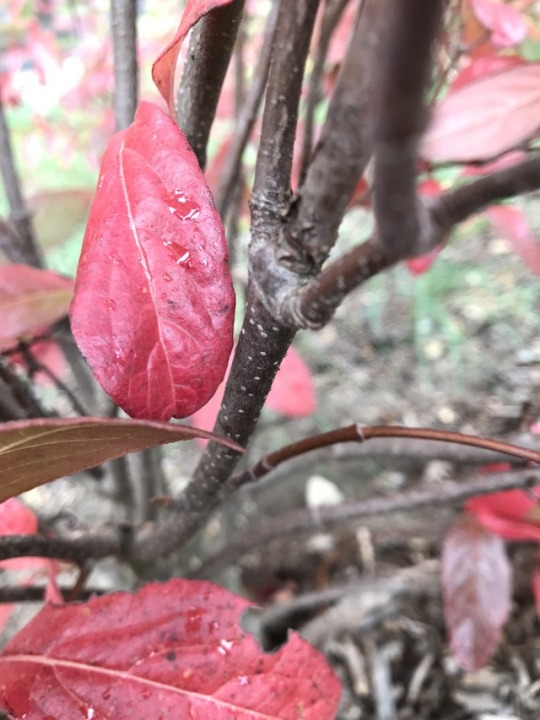



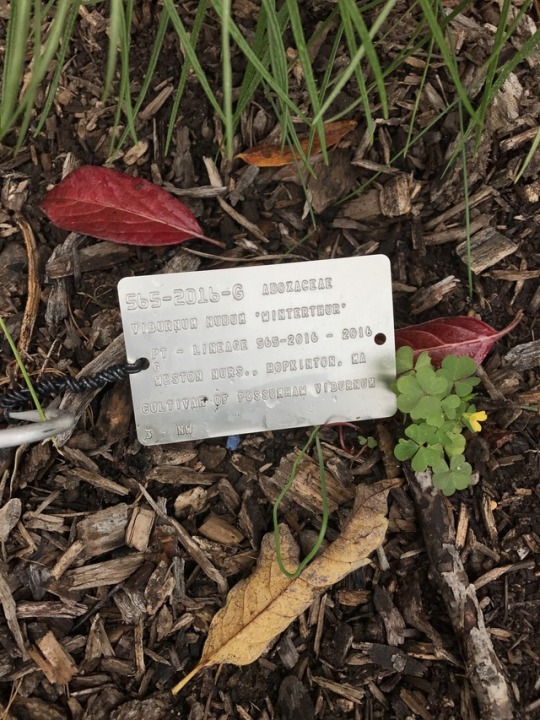
Viburnum nudum ‘winterthur’ / Cultivar of Possumhaw Viburnum
PLANT COMMUNITY: N/A
NATIVE REGION: Connecticut south to Florida and Louisiana.
MATURE SIZE: Height of 5-12′, spread of 5-12′; rounded, multi-stemmed, upright-spreading
HABITAT/GROWING CONDITIONS: Low woods, swamps, bogs; easily grown in average, medium to wet, well-drained soil in full sun to part shade
ECO-INDICATOR: N/A
HARDINESS ZONE: 5-9
LEAF COLOR: Elliptic to oblong-lanceolate glossy dark green leaves, turns an attractive maroon to dark red-purple in fall
FLOWER COLOR: Aromatic white flowers arranged in flat-topped clusters
FRUIT COLOR: Abundant, ovoid blue berries that change color as they ripen, from light pink to deep pink to blue to purplish-black; in late summer to early fall, berries in shades of both deep pink and blue-purple often appear on the same cluster, in striking contrast to the foliage
VALUE FOR REHABILITATION OF DISTURBED SITES: Viburnum nudum is recommended for stormwater retention practices because it can handle both temporary inundation and relatively protracted drought. Also it can be used for erosion control and mine reclamation.
SOURCES: Dirr, Manual of Woody Landscape Plants; http://www.missouribotanicalgarden.org/PlantFinder/PlantFinderDetails.aspx?kempercode=a659; https://www.wildflower.org/expert/show.php?id=5714; http://www.hort.cornell.edu/uhi/outreach/pdfs/woody_shrubs_stormwater_hi_res.pdf; https://sheffields.com/seeds-for-sale/Viburnum/nudum/////
#viburnum nudum 'winterthur'#possumhaw viburnum#eastern us#southern us#north america#woodlands#swamps#zone 5#zone 6#zone 7#zone 8#zone 9#stormwater retention#erosion control#mine reclamation
0 notes
Photo

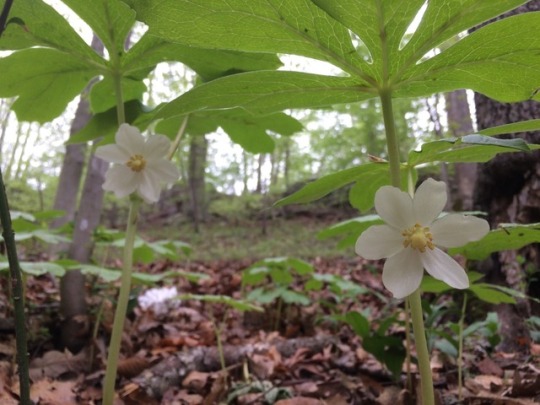





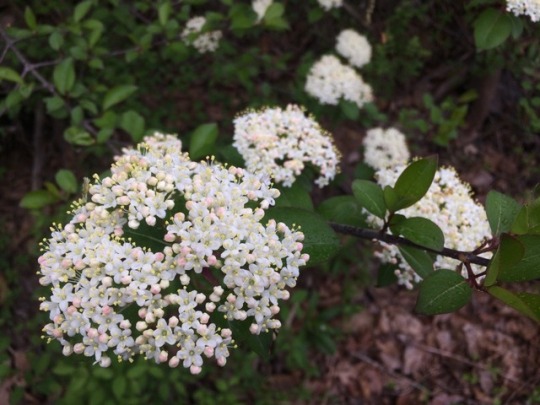


May woodland.
Left to right: American dogwoods and Autumn Olive, May apple, Wild violet, Giant Chickweed, Small’s Ragwort, Japanese Honeysuckle, Northern Highbush Blueberry, Possumhaw viburnum, Field Mustard, Autumn Olive.
38 notes
·
View notes
Photo




Viburnum nudum
Possuhum Viburnum
Location: The Rail Park - Philadelphia, PA
The Possumhaw Viburnum is a deciduous shrub native to North America. This shrub is often found growing in bogs and wet woods. It blooms fragrant white flowers in the spring and its leaves take on a yellow/crimson gradient in the fall.
Solar Exposure: Full sun
Hardiness Zones: 5-9
Preferred Soil: Loam, clay, sand; well drained; slightly acidic to neutral
(Source: PictureThis Plant ID app)
0 notes
Photo

Viburnum prunifolium (possumhaw) #cokerarboretum #ncbg #northcarolinabotanicalgarden #unc #chapelhill #springflowers #shrubs #viburnum #viburnumprunifolium #possumhaw #native #nativeplants #nativeflora #gffry (at Coker Arboretum)
#chapelhill#northcarolinabotanicalgarden#unc#gffry#viburnum#viburnumprunifolium#nativeplants#cokerarboretum#nativeflora#native#shrubs#ncbg#possumhaw#springflowers
0 notes
Text
SHRUB: Viburnum nudum (Possumhaw)
SHRUB: Viburnum nudum (Possumhaw)
Tried and True Native Plant Selections for the Mid-Atlantic
Viburnum nudum (Possumhaw) in May. Photo by Elaine L. Mills, 2015-05-25, Meadowlark Botanical Gardens.
Viburnum nudum (Possumhaw) fruit in August. Photo by Elaine L. Mills, 2017-08-24, private garden, Arlington, Virginia.
Viburnum nudum (Possumhaw) fruit in September. Photo by Elaine L. Mills, 2017-09-28, private garden,…
View On WordPress
0 notes
Photo
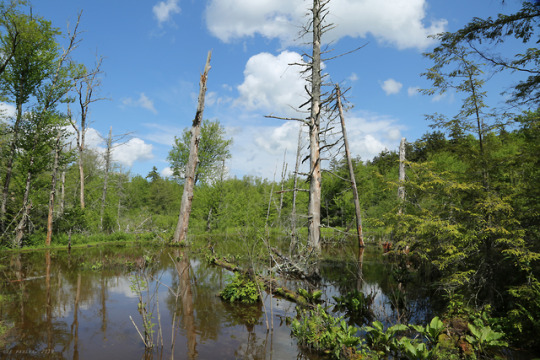
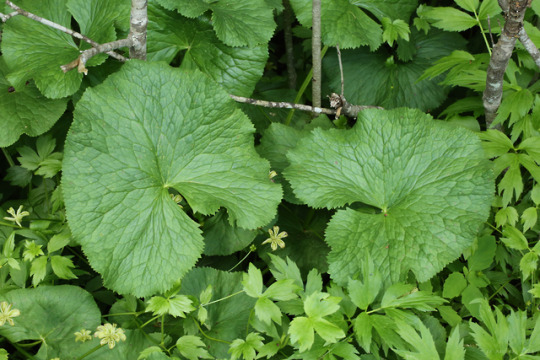








No trip on the Highland Scenic Highway is complete without a stopover at Cranberry Glades, a high-elevation bog complex nestled in the Yew Mountains. A number of birds and plants reach the southernmost or northernmost limits of their ranges in this gentle valley at the edge of the Cranberry Wilderness. Although the first wave of spring wildflowers was long gone, a nature nerd never gets bored in this place. The beavers have continued their pond expansion project along the boardwalk since last fall (top photo); a whole section of the wooden walkway is now submerged. I’ve gained a real appreciation for just how rapidly these industrious little rodents can change the character of an ecosystem. Although the marsh marigolds were well past their bloom time, their seed pods have always fascinated me (photos 2 - 3). A few other mementos from my side trip: Virginia waterleaf (photo 4), tall meadow rue (photos 5 - 6); black chokeberry (photo 7); possumhaw viburnum, also known as wild raisin (photo 8); tall meadow rue and skunk cabbage spilling onto the boardwalk (photo 9); and a view across the bog toward Black Mountain.
#appalachia#vandalia#west virginia#cranberry glades#cranberry wilderness#monongahela national forest#bog#beaver pond#marsh marigold#virginia waterleaf#tall meadow rue#black chokeberry#possumhaw viburnum#wild raisin#skunk cabbage#allegheny mountains#black mountain#yew mountains
26 notes
·
View notes
Photo

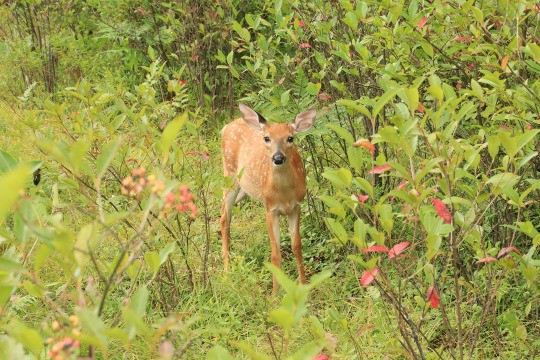
Young ‘un in the possumhaw and bracken. Momma hid close by and eventually moved on as she foraged through the bush, followed in lockstep by the fawn.
#appalachia#vandalia#west virginia#blackwater falls state park#pendleton lake#white-tailed deer#odocoileus virginianus#fawn#viburnum nudum#withe-rod#possumhaw#wild raisin
64 notes
·
View notes
Photo

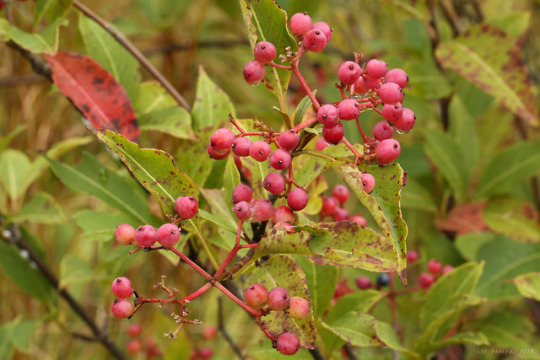
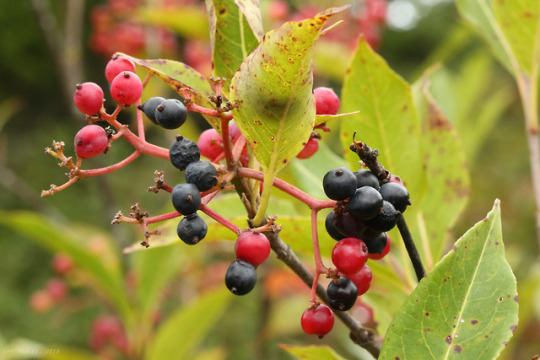
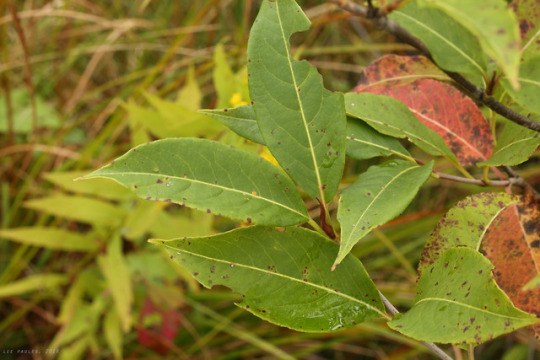
Also known as wild raisin and withe-rod, possumhaw (Viburnum nudum) is a tall, dense perennial shrub with lustrous green foliage, which turns to a gorgeous crimson shade in the fall. It grows best in the acidic soil of mountain bogs and wet meadows. The plant’s red berries form in mid to late summer and turn a deep blue to black by fall. Native American tribes once ate the berries of a possumhaw variety known as Appalachian tea (Viburnum nudum var. cassinoides), whose leaves can be dried and steeped in boiling water to make an amber tea. Possumhaw was formerly classified in the honeysuckle (Caprifoliaceae) family, although it has the appearance of a true viburnum.
#appalachia#vandalia#west virginia#fall#autumn#perennial#shrub#viburnum#possumhaw#withe-rod#wild raisin#appalachian tea
9 notes
·
View notes